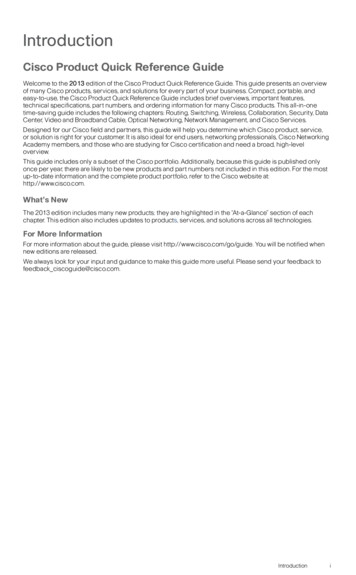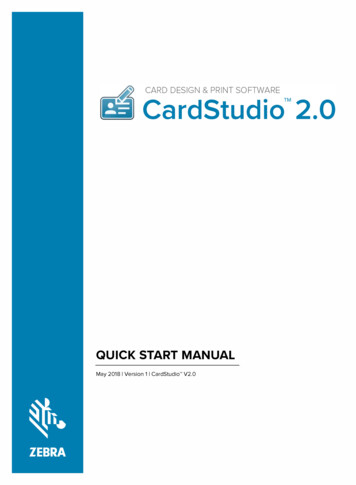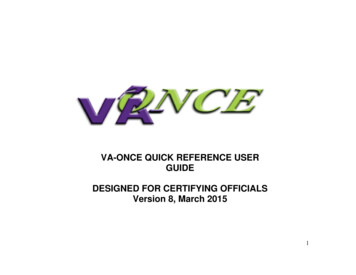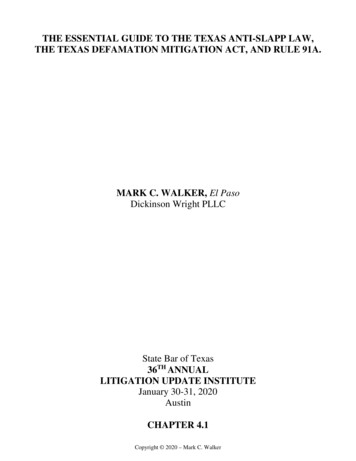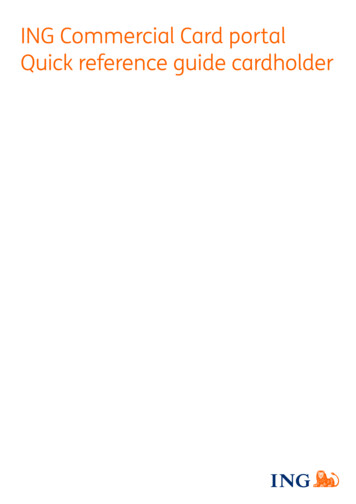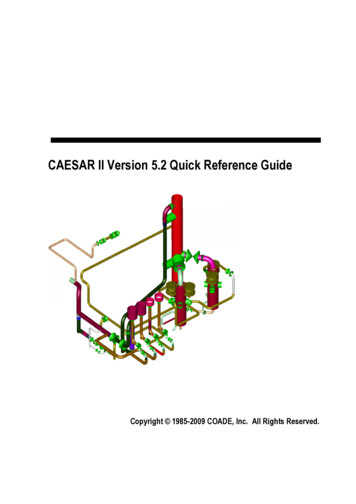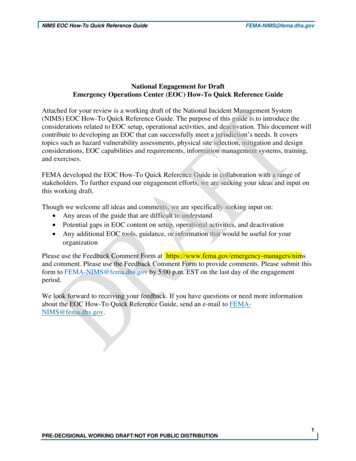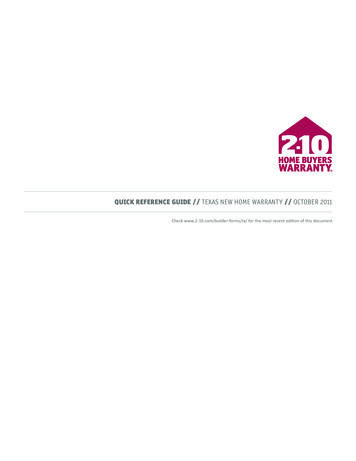
Transcription
QUICK REFERENCE GUIDE // TEXAS NEW HOME WARRANTY // OCTOBER 2011Check www.2-10.com/builder-forms/tx/ for the most recent edition of this document
TABLE OF CONTENTSTX RM QRG 1003111WELCOME2BENEFITS OF THE 2-10 HBW TEXAS WARRANTY3SIMPLE HOME ENROLLMENT CHECKLIST4CENTRAL TEXAS “HIGH-RISK” AREA5INDUSTRY STANDARD ENGINEERING AND INSPECTIONS8HELPFUL CONTACT INFORMATION AND ONLINE RESOURCES
WELCOMEWelcome to the Quick Reference Guide for the Texas New Home Warranty Program offered by the national leader inhome warranties, 2-10 Home Buyers Warranty (2-10 HBW). This Quick Reference Guide provides an overview of the2-10 HBW Program along with the information needed to begin enrolling homes once you’ve joined the Program.2-10 HBW sincerely values our Builder Members, and approved Engineers and Inspectors and have incorporated yourfeedback into the 2011 Program. In the post-Texas Residential Construction Commission (TRCC) era, 2-10 HBW hasmade significant changes to simplify, customize, and streamline the 2-10 HBW warranty program including: The new TEXAS WARRANTY based on the Texas Association of Builders warranty Elimination of HBW Slab Type requirement Elimination of Geotechnical Investigation requirement (except Central Texas High-Risk Area) Elimination of Final Grade Inspection requirement (except Central Texas High-Risk Area) Elimination of Original Construction Elevation requirement Elimination of Notice of Starts Form requirementAs was the case before TRCC regulations, Builders are free to use the foundation of their choice. Builders that prefer tocontinue to use one of the eight PTI-compliant, pre-designed, standardized slabs with related requirements consistentwith the former TRCC Program may continue to do so following the 2005 Texas Risk Management Manual. Standardizedslabs may also be used as an option under the new Texas Warranty. The Manual and an Overview of Standardized Slabsare available at www.2-10.com/builder-forms/tx/.TX RM QRG 1003111
BENEFITS OF THE 2-10 HBW TEXAS WARRANTYIt’s important to save time and money and also important that you get the product that fits your business needs.And that’s why 2-10 HBW is now offering this innovative product, available only in Texas.BUILDER BENEFITS Shifts Builder’s responsibility for structural claims to the warranty insurer resulting in “Peace of Mind” Warranty Insurer answers and reconciles phone complaints for 10-year warranty term Written “Express” Warranty with clearly defined Construction Performance Standards Fair binding arbitration to settle disputes, rather than lengthy and costly litigation Warranty is a valuable selling tool and competitive differentiatorHOMEOWNER BENEFITS Protects largest investment Coverage even if Builder goes out of business Builder is pre-qualified Confidence that home was inspected Customer Service team available to answer questionsENGINEER/INSPECTOR BENEFITS In the event of a claim, homeowner is likely to use warranty for sole remedy rather than sue multipleparties often including Engineer/Inspector 2-10 HBW promotes the use of engineers for design, resulting in quality and cost-effectiveconstruction in accordance with standard industry practice and code 2-10 HBW requires construction inspections outside building department jurisdictions to be conductedby approved Engineers/InspectorsTX RM QRG 1003112
SIMPLE HOME ENROLLMENT CHECKLISTThe home enrollment process is simple and straight-forward using either hard copy forms or an automated onlineprocess. Answers to any questions are available by calling 2-10 HBW’s toll free number 800.488.8844. The enrollmentchecklist includes:Notification of Construction (NOC) Form - Submit at least 15 days before construction.Home Enrollment Form and Payment - Submit no more than 15 days after closing.Construction Inspections - Submit any required Fee Inspector reports along with Home Enrollment Form. See Page6 for any required inspections.Upon receipt of the above a Certificate of Warranty and Home Buyers Warranty Booklet will be sent to thehomeowner. That’s it - the home is enrolled!Commercial and Multi-Family Projects, and High-End Homes (sales price over 1 million) have additional requirements.Please contact your local Sales Representative or call 800.488.8844 for additional information.TX RM QRG 1003113
CENTRAL TEXAS “HIGH-RISK” AREAThe State of Texas has a wide variety of subsurface conditions that impact foundation design and construction. TheCentral Texas Area is widely known by engineers and builders to represent an abnormally high risk for foundationmovement due to prevalent expansive soils and weather conditions that cause the soils to shrink and swell with theseasons. In fact, 2-10 HBW historic data indicates that this area represents nearly the highest risk in the United Stateswith about 10 times the frequency of structural claims as the national average. Foundation movement is the cause ofthe vast majority of structural claims. To assist Builders Members to manage their risk, 2-10 HBW has identified a portionof Central Texas as a “High-Risk” Area. This “High Risk” Area is shown below along with a table of the inclusive counties.Counties that Comprise theCentral Texas High-Risk SomervellTarrantTravisWilliamsonWiseConsistent with standard industry practice and the International Residential Code (IRC), 2-10 HBW has special enrollmentrequirements in the High-Risk Area to help Builder Members manage their risk and reduce the potential for claims. Theserequirements include: Geotechnical Investigation (1) Final Grade Inspection (2) Gutters(3)The Geotechnical Investigation shall be submitted prior to construction. The Final Grade Inspection, which confirmsgrading and gutters, shall be submitted along with the Home Enrollment form.2006 IBC Section 1803.5 specifies a Geotechnical Investigation shall be conducted for Questionable Soil, Expansive Soil, Shallow Groundwater Table, Deep Pile and Pier Foundations, Variable RockStrata, and for Fill Material more than 12 inches in depth. 2006 IRC R403.1.8.1 defines Expansive Soils as having 1) Plasticity Index (PI) of 15 or greater, 2) great than 10% passing a No. 200 sieve,3) greater than 10% less than 5 micrometers, 4) Expansion Index greater than 20. (Note: A surface grab sample or soil map reference do not substitute for a Geotechnical Investigation.)(2)2006 IRC R401.3 specifies “lots shall be graded to drain surface water away from foundation walls. The grade shall fall a minimum of 6 inches within the first 10 feet.”(3)2006 IRC R801.3 specifies “in areas where expansive or collapsible soils are known to exist, all dwellings shall have a controlled method of water disposal from roofs that will collect roof drainageto the ground surface at least 5 feet from foundation.”(1)TX RM QRG 1003114
INDUSTRY STANDARD ENGINEERING AND INSPECTIONSDID YOU KNOW?Active soils cause more property damage in the United States than the combined property damage of all floods,earthquakes, hurricanes, and tornadoes (D. Jones & W. Holtz, 1973).25% of all homes in the United States experience some structural distress over their lifetime, and 5% of all homesexperience major difficulties (R. Handy, 1995).Homeowners have about the same likelihood of experiencing major structural damage to their homes as they do forexperiencing major fire damage (E. Fluhr & P. Thomas, 1998).GEOTECHNICAL INVESTIGATION2-10 HBW’s historic data indicates that over 80% of all structural claims are caused by movement of soil under thefoundation, thus these soils are a Builder’s primary liability concern. A Geotechnical Investigation identifies andcommunicates subsurface and site conditions including subsurface soil, rock and water. Geotechnical Investigations arerecommended by most respected engineering and industry associations, and are required by an increasing number ofBuilding Departments and the IRC (see Page 4, Footnote 1). For the Builder’s benefit, 2-10 HBW maintains a list of prequalified approved engineers for Builders to use. (Engineers interested to obtain 2-10 HBW approval may visit www.210.com/builder-forms/tx/ to download an Engineer Questionnaire.)2-10 HBW’s historic data indicates that Builders that us Geotechnical Investigations are up to 50% less likely toexperience structural claims. These investigations are becoming commonplace in most parts of the country havinghigh-risk foundation support conditions (i.e., expansive, collapsible or soft soils, steep slopes, fill, etc.). The cost of theinvestigation may be offset by a site-specific lower-cost foundation, reduced claims frequency, and protection of theBuilder’s reputation. 2-10 HBW generally encourages the use of Geotechnical Investigations statewide; however, 2-10HBW requires the use of Geotechnical Investigations in the Central Texas High Risk area consistent with local standardindustry practice and the IRC.FOUNDATION DESIGNThe recommendations in the Geotechnical Investigation are used by a Structural Engineer to design the foundation. If aGeotechnical Investigation is not available, the Structural Engineer shall be knowledgeable of the subsurface conditionsat the specific property and plan for worst case conditions. It is standard industry practice to design foundations inaccordance with the most recent editions of the Post-Tensioning Institute’s (PTI) publication “Design of Post-TensionedSlabs-On-Ground,” American Concrete Institute (ACI), and the Texas Section of the American Society of Civil Engineers(ASCE) publication “Recommended Practice for the Design of Residential Foundations.” Expansive soils are prevalent inTexas and the International Building Code, Section 1808.6, provides requirements for proper design on expansive soils.TX RM QRG 1003115
INDUSTRY STANDARD ENGINEERING AND INSPECTIONSCONSTRUCTION INSPECTIONSInspections are a vital component of the home construction industry, as they are in most industries. Homeconstruction inspections are standard industry practice and required by Building Departments, FHA/HUD, IRC, and 2-10HBW. Inspections assist Builders to ensure that homes are constructed in accordance with the plans and specifications,construction performance standards, and applicable building codes. In areas without local codes, 2-10 HBW andmost authorities recognize the most recent edition of the IRC. In order for a home to be eligible for enrollment in the2-10 HBW Program, it must be inspected at a minimum at foundation, frame, and final stages by either a BuildingDepartment or a Fee Inspector.2-10 HBW’s Risk Management Team interviews and evaluates thousands of Building Departments (BD) nationwideto determine the type and quality of inspections conducted by each BD. Based on this evaluation, 2-10 HBW mayfind that a BD does not conduct or is not qualified to conduct certain critical inspections. Thus 2-10 HBW may relyon a BD to conduct only some or all of the required inspections. In areas with unapproved BDs or not under thejurisdiction of a BD, 2-10 HBW maintains an extensive list of approved third-party Fee Inspectors to fulfill inspectionrequirements on behalf of the Builder.To benefit Builder Members, inspectors are evaluated to determine if they have at least 5 years directly applicableexperience or have an acceptable professional certification(s). Builders can contact 2-10 HBW to determine theapproval status of a particular BD and to identify HBW-approved inspectors. (Qualified inspectors interested to obtain2-10 HBW approval may visit www.2-10.com/builder-forms/tx/ to download an Independent Contractors Applicationand Inspection Referral Agreement.)2-10 HBW prefers that inspectors use 2-10 HBW inspection forms. These checklist forms are numbered U-31, U-32,and U-33 for foundation, frame, and final inspections, respectively. One copy shall be left at the jobsite, one copy sentto 2-10 HBW, and one copy for the inspector’s records. Blank forms that simply state “passed or failed” are generallyconsidered to contain insufficient detail. Builders are responsible to ensure that all inspections by approved FeeInspectors and Engineers are submitted to 2-10 HBW.In the Central Texas High-Risk Area a Final Grade Inspection is also required for all enrollments. The results of the Final GradeInspection shall be documented on 2-10 HBW Form U-34 and submitted to 2-10 HBW. Additionally, other inspections maybe required statewide depending on the type of foundation. These inspections include Post-Tensioned Cable StressingInspection and Deep Pier/Pile Inspection, as applicable. A summary of inspection requirements is presented below.TX RM QRG 1003116
INDUSTRY STANDARD ENGINEERING AND INSPECTIONSROUTINE CONSTRUCTION INSPECTIONSFOUNDATION INSPECTION (Form U-31)Almost all BDs are approved to inspect Rebar foundations, and a limitednumber are approved to inspect Post-Tensioned foundations.FRAME INSPECTION (Form U-32)Almost all BDs are approved for this inspection.FINAL INSPECTION (Form U-33)Almost all BDs are approved for this inspection.ADDITIONAL CONSTRUCTION INSPECTIONS AS APPLICABLEPOST-TENSIONED CABLE STRESSING INSPECTION (Engineer Letter)A limited number of BDs are approved to conduct this inspection. Typically a Fee Inspector conductsthe inspection on behalf of the Structural Engineer and Engineer provides a stamped letter.DEEP PIER OR PILE INSPECTION (Form U-31)A limited number of BDs are approved to conduct this inspection.FINAL GRADE INSPECTION (Form U-34)A limited number of BDs are approved to conduct this inspection. It may be convenient for yourRegistered Surveyor to conduct this inspection.Inspections should be submitted to 2-10 HBW along with the Home Enrollment form so the homeenrollment is not delayed. If there are any questions regarding inspections or the approval status of aBD, engineer, or fee inspector, contact your local Sales Representative or call Enrollment Compliance at800.488.8844.TX RM QRG 1003117
HELPFUL CONTACT INFORMATION AND ONLINE RESOURCES2-10 HBW is standing by to answer any questions. Please call 800.488.8844.MAILEMAILFAX2-10 HOME BUYERS WARRANTYAttn: Enrollment Compliance Dept.P.O. Box 371348Denver, CO 802372-10HBW@2-10.com303.306.2222DOCUMENTS REFERENCED IN THIS GUIDE ARE AVAILABLE ONLINE ATWWW.2-10.COM/BUILDER-FORMS/TX Notice of Construction Builder Application for Home Enrollment Inspection Forms Independent Contractors Application Inspection Referral Agreement Engineer Questionnaire 2005 Risk Management Manual Overview of Standardized Slabs-on-GroundWEBSITES FOR ASSOCIATIONS AND PUBLICATIONS REFERENCED IN THIS GUIDE International Residential Code for One- and Two-Family Dwellings (www.iccsafe.org) Post-Tensioning Institute’s (PTI) Publication “Design of Post-Tensioned Slabs-on-Ground” (www.post-tensioning.org) The Texas Section of the American Society of Civil Engineers (ASCE) Publication “Recommended Practice for theDesign of Residential Foundations” (www.texasce.org) American Concrete Institute (www.concrete.org)TX RM QRG 1003118
Welcome to the Quick Reference Guide for the Texas New Home Warranty Program offered by the national leader in home warranties, 2-10 Home Buyers Warranty (2-10 HBW). This Quick Reference Guide provides an overview of the 2-10 HBW Program along with the information needed to begin enrolling homes once you've joined the Program.

